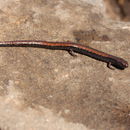Description
provided by AmphibiaWeb articles
This is a moderately sized species; adult standard length averages 23.2 mm in 11 males (range 20.5-25.4) and 23.6 mm in 14 females (range 19.9-25.9). The head is moderately wide; SL averages 7.5 times head width in males (range 6.9-7.8) and 7.6 times head width in females (range 7.1-8.4). Snouts are bluntly pointed. Nostrils are oval in shape; the mean ratio of major axis to minor axis equals 1.3 both in males (range 1.1-1.5) and in females (range 1.1-1.6). Eyes are small and barely intersect the margin of the jaw in dorsal view. A suborbital groove intersects the lip on each side of the head. There is a prominent parotoid gland on each side of the neck above the protuberance marking the posterior tip of the epibranchial cartilage. There are 0-2 premaxillary teeth in males (mean 1.7) and 0-3 in females (mean 1.1). Vomerine teeth average 8.2 in males (range 6-11) and 9.1 in females (range 8-10). There are no maxillary teeth. Limbs are relatively long; limb interval averages 4.0 in males and 3.8 in females (range 3-5 in both sexes). Hands and feet are moderately long. Only the two longest fingers and three longest toes are free at their tips, which are rounded rather than pointed in adults. Fingers, in order of decreasing length, are 3-2-4-1; toes are 3-(2-4)-(1-5). The tail is long and slender; mean SL divided by tail length equals 0.95 in males (range 0.76-1.19) and 0.86 in females (range 0.76-1.00). The postiliac gland is evident, but the mental gland is faint or indistinct. Secondary sexual characters are inconspicuous in males; sexual dimorphism is slight. Coloration varies little from the holotype; the dorsal band is more evident on some specimens than others. Some large males are very dark and have dark pigment concentrated in the grooves between the digits. Spots on the head are always very faint.According to field notes by D. B. Wake (25 July 1979), specimens collected from 6 km W of Las Vigas had a tan-gold dorsal stripe and at least superficially resembled T. troglodytes from Puerto del Aire. The iris is black (Hanken and Wake 1998).Etymology. The species name is derived from the Latin word munificus, meaning bountiful, or generous. The species is dedicated in honor of Roy W. McDiarmid, in recognition of his longstanding interests in and contributions to the biology of tropical salamanders, especially those of Veracruz, Mexico, and who has graciously shared his knowledge and insights with us on many occasions (Hanken and Wake 1998).
Distribution and Habitat
provided by AmphibiaWeb articles
Thorius munificus is known from Las Vigas, Veracruz, Mexico (19°35'18" N, 97°05'34" W), and from adjacent localities within a few kilometers both east and especially west. Recorded elevations range from 2380 to 2525 m (included in Wake et al. 1992 as Thorius sp. nov.). All specimens have been collected in terrestrial microhabitats within pine or pine-oak forest. According to field notes by D. B. Wake, the locality at 4.5 km W of Las Vigas (25 July 1976) comprises dense pine woods with a few oaks and abundant representation of plants characteristic of temperate woodlands in northern North America, including the genera Pteridium, Adianthum, Monotropa, and Lupinus, as well as herbaceous ericaceous species and saprophytic orchids. Large numbers of T. munificus were observed under the abundant ground cover, which mainly comprised pine logs and branches. The site located 6 km W of Las Vigas (25 July 1979) was a mixed woodland of oak, pine and madrone, with abundant shrubby Baccharis and again with Monotropa and other ericaceous plants. Salamanders of several species (T. munificus, Pseudoeurycea leprosa, P. cephalica, and Chiropterotriton chiropterus) were "incredibly abundant" under the bark of fallen logs and on the ground in litter and under logs and fallen branches (Hanken and Wake 1998).
Thorius munificus: Brief Summary
provided by wikipedia EN
Thorius munificus is a species of salamander in the family Plethodontidae. It is endemic to Mexico and only known from near its type locality near Las Vigas, Veracruz. Its natural habitats are pine-oak and pine forests, woodlands, and Arbutus forests with abundant shrubby and ericaceous plants. The species is threatened by habitat loss caused by logging, agriculture, and human settlement.
- license
- cc-by-sa-3.0
- copyright
- Wikipedia authors and editors

